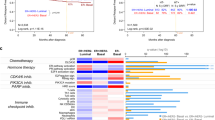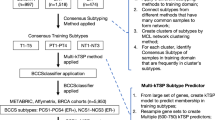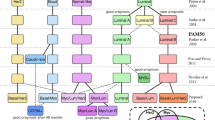Abstract
Gene-expression profiling of breast cancers has shown that distinct molecular subclasses are present within tumors that are apparently morphologically similar. The molecular subclasses of cohorts classified by the 'intrinsic' gene set include the luminal A and B, erbB-2+, normal-breast-like, and basal-like tumors. Basal-like breast cancers have been reported to be associated with worse overall and disease-free survival compared with the luminal A subtype. In addition, there is an immunohistochemical surrogate for the basal-like profile, which has considerably facilitated their study in non-specialty laboratories. Basal-like breast carcinomas have markedly reduced expression of genes related to estrogen receptors and erbB-2, and express proteins that are characteristic of the normal myoepithelial cell. This Review appraises the current state of knowledge on the clinical and pathologic features of breast cancers classified as 'basal-like' by gene-expression profiling and/or immunohistochemical criteria. These tumors seem to be relatively heterogeneous according to a multitude of clinicopathologic parameters, which indicates that their most prognostically relevant subsets have yet to be defined. Similarly to tumors of luminal epithelial differentiation, carcinomas of the 'basal' type have a spectrum of morphologic and clinical characteristics.
Key Points
-
Gene-expression profiling has shown that approximately 20% of invasive breast carcinomas have an increased expression of genes present in the normal myoepithelial cell of the breast, with concurrent decreased expression of estrogen receptor and HER2-related genes
-
Basal-like breast cancers (BLBCs) can be identified immunohistochemically, although international consensus on an immunohistochemical definition remains elusive
-
BLBCs display high proliferative activity and seem to be over-represented in cancers arising in BRCA1 germline mutation carriers and premenopausal African American women
-
Pathologically, most BLBCs are of the ductal histotype and display a pushing border, high histologic grade, stromal lymphocytic infiltrate, and necrosis
-
Medullary cancers have a basal-like gene-expression profile, and traditional myoepithelial-type carcinomas, metaplastic carcinomas, and small subsets of other histotypes can also be classified as basal-like by immunohistochemical criteria
-
Although prognostic data on BLBCs are not entirely congruent, most studies have shown that BLBCs are associated with decreased overall and disease-free survival compared with their luminal A counterparts; it is unclear whether the prognostic significance of the basal-like phenotype is truly independent of estrogen receptor status or histologic grade
This is a preview of subscription content, access via your institution
Access options
Subscribe to this journal
Receive 12 print issues and online access
$209.00 per year
only $17.42 per issue
Buy this article
- Purchase on Springer Link
- Instant access to full article PDF
Prices may be subject to local taxes which are calculated during checkout
Similar content being viewed by others
References
Jemal A et al. (2007) Cancer statistics, 2007. CA Cancer J Clin 57: 43–66
Surveillance, Epidemiology, and End Results (SEER) Program (www.seer.cancer.gov) SEER*Stat Database: Incidence - SEER 17 Regs Public-Use, Nov 2005 Sub (1973-2003 varying), National Cancer Institute, DCCPS, Surveillance Research Program, Cancer Statistics Branch, released April 2006, based on the November 2005 submission
Goldhirsch A et al. (2005) Meeting highlights: international expert consensus on the primary therapy of early breast cancer 2005. Ann Oncol 16: 1569–1583
Eifel P et al. (2001) National Institutes of Health Consensus Development Conference Statement: adjuvant therapy for breast cancer, November 1–3, 2000. J Natl Cancer Inst 93: 979–989
Early Breast Cancer Trialists' Collaborative Group (1988). Effects of adjuvant tamoxifen and of cytotoxic therapy on mortality in early breast cancer. An overview of 61 randomized trials among 28,896 women. N Engl J Med 319: 1681–1692
Pease AC et al. (1994) Generated oligonucleotide arrays for rapid DNA sequence analysis. Proc Natl Acad Sci USA 91: 5022–5026
Lipshutz RJ et al. (1995) Using oligonucleotide probe arrays to access genetic diversity. Biotechniques 19: 442–447
Schena M et al. (1995) Quantitative monitoring of gene expression patterns with a complementary DNA microarray. Science 270: 467–470
Quackenbush J (2006) Microarray analysis and tumor classification. N Engl J Med 354: 2463–2472
Reis-Filho JS et al. (2006) The impact of expression profiling on prognostic and predictive testing in breast cancer. J Clin Pathol 59: 225–231
Brenton JD et al. (2005) Molecular classification and molecular forecasting of breast cancer: ready for clinical application? J Clin Oncol 23: 7350–7360
Sorlie T (2007) Molecular classification of breast tumors: toward improved diagnostics and treatments. Methods Mol Biol 360: 91–114
Perou CM et al. (2000) Molecular portraits of human breast tumours. Nature 406: 747–752
Murad TM (1971) A proposed histochemical and electron microscopic classification of human breast cancer according to cell of origin. Cancer 27: 288–299
Hamperl H (1970) The myothelia (myoepithelial cells). Normal state; regressive changes; hyperplasia; tumors. Curr Top Pathol 53: 161–220
Fadare O and Tavassoli FA (2007) The phenotypic spectrum of basal-like breast cancers: a critical appraisal. Adv Anat Pathol 14: 358–373
Sorlie T et al. (2001) Gene expression patterns of breast carcinomas distinguish tumor subclasses with clinical implications. Proc Natl Acad Sci USA 98: 10869–10874
Sorlie T et al. (2003) Repeated observation of breast tumor subtypes in independent gene expression data sets. Proc Natl Acad Sci USA 100: 8418–8423
Calza S et al. (2006) Intrinsic molecular signature of breast cancer in a population-based cohort of 412 patients. Breast Cancer Res 8: R34
Sotiriou C et al. (2003). Breast cancer classification and prognosis based on gene expression profiles from a population-based study. Proc Natl Acad Sci USA 100: 10393–10398
Hu Z et al. (2006) The molecular portraits of breast tumors are conserved across microarray platforms. BMC Genomics 7: 96
Perreard L et al. (2006) Classification and risk stratification of invasive breast carcinomas using a real-time quantitative RT-PCR assay. Breast Cancer Res 8: R23
Fan C et al. (2006) Concordance among gene-expression-based predictors for breast cancer. N Engl J Med 355: 560–569
van 't Veer LJ et al. (2003) Expression profiling predicts outcome in breast cancer. Breast Cancer Res 5: 57–58
van de Vijver MJ et al. (2002) A gene-expression signature as a predictor of survival in breast cancer. N Engl J Med 347: 1999–2009
van 't Veer LJ et al. (2002) Gene expression profiling predicts clinical outcome of breast cancer. Nature 415: 530–536
Chang HY et al. (2005) Robustness, scalability, and integration of a wound-response gene expression signature in predicting breast cancer survival. Proc Natl Acad Sci USA 102: 3738–3743
Paik S et al. (2004) A multigene assay to predict recurrence of tamoxifen-treated, node-negative breast cancer. N Engl J Med 351: 2817–2826
Paik S et al. (2006) Gene expression and benefit of chemotherapy in women with node-negative, estrogen receptor-positive breast cancer. J Clin Oncol 24: 3726–3734
Weigelt B et al. (2005) Molecular portraits and 70-gene prognosis signature are preserved throughout the metastatic process of breast cancer. Cancer Res 65: 9155–9158
Lacroix M et al. (2004) Stable 'portrait' of breast tumors during progression: data from biology, pathology and genetics. Endocr Relat Cancer 11: 497–522
Li H et al. (2007) Nestin is expressed in the basal/myoepithelial layer of the mammary gland and is a selective marker of basal epithelial breast tumors. Cancer Res 67: 501–510
Jumppanen M et al. (2007) Basal-like phenotype is not associated with patient survival in estrogen receptor negative breast cancers. Breast Cancer Res 9: R16
Ribeiro-Silva A et al. (2005) p63 correlates with both BRCA1 and cytokeratin 5 in invasive breast carcinomas: further evidence for the pathogenesis of the basal phenotype of breast cancer. Histopathology 47: 458–466
Jacquemier J et al. (2005) Typical medullary breast carcinomas have a basal/myoepithelial phenotype. J Pathol 207: 260–268
Kesse-Adu R and Shousha S (2004) Myoepithelial markers are expressed in at least 29% of oestrogen receptor negative invasive breast carcinoma. Mod Pathol 17: 646–652
Rodriguez-Pinilla SM et al. (2007) Sox2: a possible driver of the basal-like phenotype in sporadic breast cancer. Mod Pathol 20: 474–481
Harris LN et al. (2007) Predictors of resistance to preoperative trastuzumab and vinorelbine for HER2-positive early breast cancer. Clin Cancer Res 13: 1198–1207
Garcia S et al. (2007) Poor prognosis in breast carcinomas correlates with increased expression of targetable CD146 and c-Met and with proteomic basal-like phenotype. Hum Pathol 38: 830–841
Foulkes WD et al. (2004) The prognostic implication of the basal-like (cyclin E high/p27 low/p53+/glomeruloid-microvascular-proliferation+) phenotype of BRCA1-related breast cancer. Cancer Res 64: 830–835
Hannemann J et al. (2006) Molecular subtypes of breast cancer and amplification of topoisomerase II alpha: predictive role in dose intensive adjuvant chemotherapy. Br J Cancer 95: 1334–1341
Jones C et al. (2004) Molecular cytogenetic identification of subgroups of grade III invasive ductal breast carcinomas with different clinical outcomes. Clin Cancer Res 10: 5988–5997
Foulkes WD et al. (2003) Germline BRCA1 mutations and a basal epithelial phenotype in breast cancer. J Natl Cancer Inst 95: 1482–1485
van der Groep P et al. (2004) Re: Germline BRCA1 mutations and a basal epithelial phenotype in breast cancer. J Natl Cancer Inst 96: 712–713
Palacios J et al. (2004) Re: Germline BRCA1 mutations and a basal epithelial phenotype in breast cancer. J Natl Cancer Inst 96: 712–714
Siziopikou KP and Cobleigh M (2007) The basal subtype of breast carcinomas may represent the group of breast tumors that could benefit from EGFR-targeted therapies. Breast 16: 104–107
Rakha EA et al. (2006) Morphological and immunophenotypic analysis of breast carcinomas with basal and myoepithelial differentiation. J Pathol 208: 495–506
Banerjee S et al. (2006) Basal-like breast carcinomas: clinical outcome and response to chemotherapy. J Clin Pathol 59: 729–735
Livasy CA et al. (2006) Phenotypic evaluation of the basal-like subtype of invasive breast carcinoma. Mod Pathol 19: 264–271
Nielsen TO et al. (2004) Immunohistochemical and clinical characterization of the basal-like subtype of invasive breast carcinoma. Clin Cancer Res 10: 5367–5374
Kim MJ et al. (2006) Clinicopathologic significance of the basal-like subtype of breast cancer: a comparison with hormone receptor and Her2/neu-overexpressing phenotypes. Hum Pathol 37: 1217–1226
Kusinska R et al. (2005) Immunohistochemical identification of basal-type cytokeratins in invasive ductal breast carcinoma--relation with grade, stage, estrogen receptor and HER2. Pol J Pathol 56: 107–110
Rodriguez-Pinilla SM et al. (2007) Vimentin and laminin expression is associated with basal-like phenotype in both sporadic and BRCA1-associated breast carcinomas. J Clin Pathol 60: 1006–1012
Rodriguez-Pinilla SM et al. (2006) Prognostic significance of basal-like phenotype and fascin expression in node-negative invasive breast carcinomas. Clin Cancer Res 12: 1533–1539
Ribeiro-Silva A et al. (2006) Vascular endothelial growth factor expression in the basal subtype of breast carcinoma. Am J Clin Pathol 125: 512–518
van de Rijn M et al. (2002) Expression of cytokeratins 17 and 5 identifies a group of breast carcinomas with poor clinical outcome. Am J Pathol 161: 1991–1996
Abd El-Rehim DM et al. (2004) Expression of luminal and basal cytokeratins in human breast carcinoma. J Pathol 203: 661–671
Kesse-Adu R and Shousha S (2004) Myoepithelial markers are expressed in at least 29% of oestrogen receptor negative invasive breast carcinoma. Mod Pathol 17: 646–652
Hicks DG et al. (2006) Breast cancers with brain metastases are more likely to be estrogen receptor negative, express the basal cytokeratin CK5/6, and overexpress HER2 or EGFR. Am J Surg Pathol 30: 1097–1104
Potemski P et al. (2005) Prognostic relevance of basal cytokeratin expression in operable breast cancer. Oncology 69: 478–485
Charafe-Jauffret E et al. (2006) Gene expression profiling of breast cell lines identifies potential new basal markers. Oncogene 25: 2273–2284
Rouzier R et al. (2005) Breast cancer molecular subtypes respond differently to preoperative chemotherapy. Clin Cancer Res 11: 5678–5685
Lakhani SR et al. (2005) Prediction of BRCA1 status in patients with breast cancer using estrogen receptor and basal phenotype. Clin Cancer Res 11: 5175–5180
Laakso M et al. (2005) Cytokeratin 5/14-positive breast cancer: true basal phenotype confined to BRCA1 tumors. Mod Pathol 18: 1321–1328
Abd El-Rehim DM et al. (2004) Expression of luminal and basal cytokeratins in human breast carcinoma. J Pathol 203: 661–671
Reis-Filho JS et al. (2006) Distribution and significance of nerve growth factor receptor (NGFR/p75NTR) in normal, benign and malignant breast tissue. Mod Pathol 19: 307–319
Rodriguez Pinilla SM et al. (2006) Caveolin-1 expression is associated with a basal-like phenotype in sporadic and hereditary breast cancer. Breast Cancer Res Treat 99: 85–90
Arnes JB et al. (2005) Placental cadherin and the basal epithelial phenotype of BRCA1-related breast cancer. Clin Cancer Res 11: 4003–4011
Fulford LG et al. (2006) Specific morphological features predictive for the basal phenotype in grade 3 invasive ductal carcinoma of breast. Histopathology 49: 22–34
Matos I et al. (2005) p63, cytokeratin 5, and P-cadherin: three molecular markers to distinguish basal phenotype in breast carcinomas. Virchows Arch 447: 688–694
Rakha EA et al. (2007) Prognostic markers in triple-negative breast cancer. Cancer 109: 25–32
Rakha EA et al. (2006) Basal phenotype identifies a poor prognostic subgroup of breast cancer of clinical importance. Eur J Cancer 42: 3149–3156
Carey LA et al. (2006) Race, breast cancer subtypes, and survival in the Carolina Breast Cancer Study. JAMA 295: 2492–2502
Collett K et al. (2005) A basal epithelial phenotype is more frequent in interval breast cancers compared with screen detected tumors. Cancer Epidemiol Biomarkers Prev 14: 1108–1112
Paredes J et al. (2005) P-cadherin overexpression is an indicator of clinical outcome in invasive breast carcinomas and is associated with CDH3 promoter hypomethylation. Clin Cancer Res 11: 5869–5877
Savage K et al. (2007) Caveolin 1 is overexpressed and amplified in a subset of basal-like and metaplastic breast carcinomas: a morphologic, ultrastructural, immunohistochemical, and in situ hybridization analysis. Clin Cancer Res 13: 90–101
Reis-Filho JS et al. (2006) Metaplastic breast carcinomas are basal-like tumours. Histopathology 49: 10–21
Fulford LG et al. (2007) Basal-like grade III invasive ductal carcinoma of the breast: patterns of metastasis and long-term survival. Breast Cancer Res 9: R4
Yang XR et al. (2007) Differences in risk factors for breast cancer molecular subtypes in a population-based study. Cancer Epidemiol Biomarkers Prev 16: 439–443
Rakha EA et al. (2007) Breast carcinoma with basal differentiation: a proposal for pathology definition based on basal cytokeratin expression. Histopathology 50: 434–438
Galaburda LS et al. (2007) Are the different molecularly-defined subtypes of invasive breast cancer associated with different reproductive risk factors? [abstract] Mod Pathol 20 (Suppl 2): 31A
Fadare O and Yeh IT (2007) Basal-like breast cancers. Pathol Case Rev 12: 143–153
Seewaldt VL and Scott V (2007) Images in clinical medicine. Rapid progression of basal-type breast cancer. N Engl J Med 356: e12
Turner NC and Reis-Filho JS (2006) Basal-like breast cancer and the BRCA1 phenotype. Oncogene 25: 5846–5853
Tischkowitz MD and Foulkes WD (2006) The basal phenotype of BRCA1-related breast cancer: past, present and future. Cell Cycle 5: 963–967
Tsuda H et al. (1999) Myoepithelial differentiation in high-grade invasive ductal carcinomas with large central acellular zones. Hum Pathol 10: 1134–1139
Tsuda H et al. (2000) Large, central acellular zones indicating myoepithelial tumor differentiaton in high-grade invasive ductal carcinomas as markers of predisposition to lung and brain metastases. Am J Surg Pathol 24: 197–202
Albiges L et al. (2005) Spectrum of breast cancer metastasis in BRCA1 mutation carriers: highly increased incidence of brain metastases. Ann Oncol 16: 1846–1847
Diallo-Danebrock R et al. (2007) Protein expression profiling in high-risk breast cancer patients treated with high-dose or conventional dose-dense chemotherapy. Clin Cancer Res 13: 488–497
Harris LN et al. (2007) Predictors of resistance to preoperative trastuzumab and vinorelbine for HER2-positive early breast cancer. Clin Cancer Res 13: 1198–1207
Finn RS et al. (2007) Dasatinib, an orally active small molecule inhibitor of both the src and abl kinases, selectively inhibits growth of basal-type/“triple-negative” breast cancer cell lines growing in vitro. Breast Cancer Res Treat 105: 319–326
Moyano JV et al. (2006) AlphaB-crystallin is a novel oncoprotein that predicts poor clinical outcome in breast cancer. J Clin Invest 116: 261–270
Flanagan M et al. (2007) EGFR gene amplification is an uncommon event in basal-like breast carcinomas [abstract]. Lab Invest 87 (Suppl 1): 31A
Malzahn K et al. (1998) Biological and prognostic significance of stratified epithelial cytokeratins in infiltrating ductal breast carcinomas. Virchows Arch 433: 119–129
Bertucci F et al. (2006) Gene expression profiling shows medullary breast cancer is a subgroup of basal breast cancers. Cancer Res 66: 4636–4344
Rodriguez-Pinilla SM et al. (2007) Sporadic invasive breast carcinomas with medullary features display a basal-like phenotype: an immunohistochemical and gene amplification study. Am J Surg Pathol 31: 501–508
Vincent-Salomon A et al. (2007) Identification of typical medullary breast carcinoma as a genomic sub-group of basal-like carcinomas, a heterogeneous new molecular entity. Breast Cancer Res 9: R24
Koenig C et al. (2000) Carcinoma arising in microglandular adenosis: an immunohistochemical analysis of 20 intraepithelial and invasive neoplasms. Int J Surg Pathol 8: 303–315
Finak G et al. (2006) Gene expression signatures of morphologically normal breast tissue identify basal-like tumors. Breast Cancer Res 8: R58
Sun Y et al. (2007) Improved breast cancer prognosis through the combination of clinical and genetic markers. Bioinformatics 23: 30–37
Acknowledgements
The views expressed in this article are those of the authors and do not reflect the official policy of the Department of Defense or other Departments of the United States Government.
Author information
Authors and Affiliations
Corresponding author
Ethics declarations
Competing interests
The authors declare no competing financial interests.
Rights and permissions
About this article
Cite this article
Fadare, O., Tavassoli, F. Clinical and pathologic aspects of basal-like breast cancers. Nat Rev Clin Oncol 5, 149–159 (2008). https://doi.org/10.1038/ncponc1038
Received:
Accepted:
Published:
Issue Date:
DOI: https://doi.org/10.1038/ncponc1038
This article is cited by
-
Membranous overexpression of S100A10 is associated with a high-grade cellular status of breast carcinoma
Medical Molecular Morphology (2020)
-
ME1 promotes basal-like breast cancer progression and associates with poor prognosis
Scientific Reports (2018)
-
Basal-like breast cancer: molecular profiles, clinical features and survival outcomes
BMC Medical Genomics (2017)
-
Gene expression in local stroma reflects breast tumor states and predicts patient outcome
Scientific Reports (2016)
-
Arsenic-induced cancer cell phenotype in human breast epithelia is estrogen receptor-independent but involves aromatase activation
Archives of Toxicology (2014)



